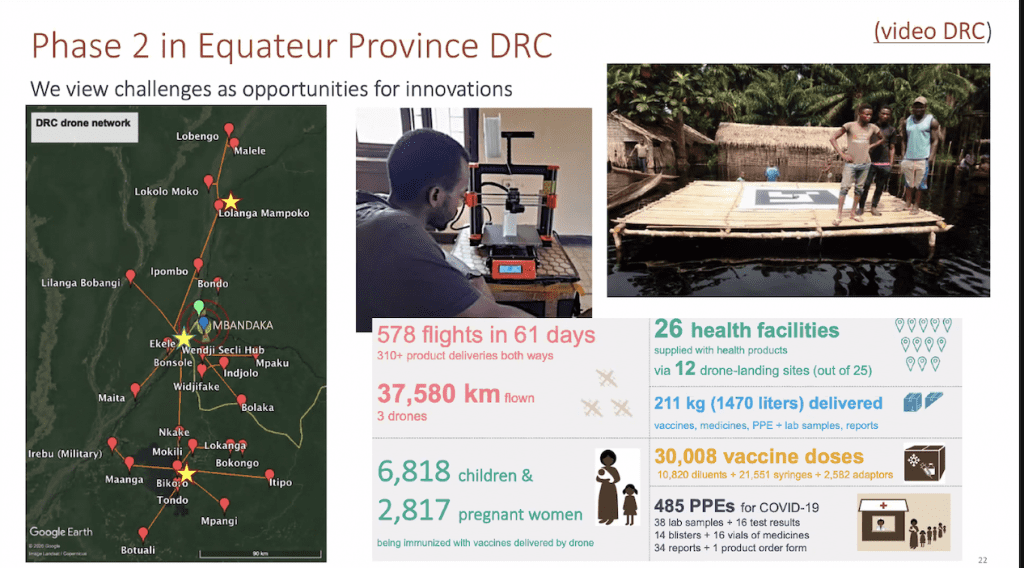Are Drones the Answer to More Equitable Health Care?


VillageReach uses Swoop Aero’s drones in its drone delivery operations in Africa. (image from Swoop Aero’s website)
The development of advanced air mobility vehicles is opening doors for the use of aircraft in new ways. While the use of drones for civilian and commercial missions is not widespread yet, there are some projects exploring their use and showing the world how these aircraft could be utilized. In Africa, some organizations, such as VillageReach, have started using drones for medical supplies.
VillageReach is an NGO working to improve the way health products like vaccines, medicines, and laboratory samples are transported in developing countries, Oliver Defawe, director of health systems at Village Reach, explained in a May 18 webinar.
“This operation not only allows us and the governments to get experience with drone technology, but they also help generate hard evidence in data on the benefits on the supply chain performance and cost,” Defawe said.
Phase one of using drones in this project concerned safety and feasibility testing. VillageReach had to get permission to import and use the drones and explore the costs and benefits of implementing them into the system.
“The first challenge that we took was on designing, implementing, and scaling a new supply chain model that got vaccines to the children in an extremely rural and hard to reach area in Mozambique,” Defawe said.
This phase also included evaluating which technology would be used in the project. VillageReach put out a global request for proposals to select a drone partner, Defawe said. The chosen partner, Swoop Aero, also had to conduct test flights and train staff on drone operations.
VillageReach then expanded its focus to the system which the drones would support, Defawe said.
“From there we have extended into a broader mandate around supporting the system delivering medicines supplies,” Defawe said. “VillageReach is made of professionals with extensive expertise in supply chain, health workforce and development, digital health technology, and data analytics. These components are all developed out of our strong belief that the system that delivers most include not just the supply side but also the data in the system that drives demand.”

The successes and obstacles of VillageReach’s drone delivery project in Africa could provide information on how drone projects elsewhere proceed. (image from webinar presentation)
Defawe said the project has had mixed successes five years in. They were able to deliver 25 kilograms of vaccines and syringes to five rural health areas to immunize 470 children, complete 80 kilometer round trips at 115 kilometers per hour reducing transport times from three hours to just 20 minutes and maintain a cold chain.
“This has lasted five years, almost six now, when mixed with successes,” Defawe said. “Like in the DR Congo, with the first drone supported vaccination session in West and Central Africa… but also setbacks. But at the end, the experience made village reach one of the most know-how partners in the drone delivery space and is allowing us to lead the way on the international stage.”
One of the biggest issues they have had during this project was the loss of connectivity, Defawe said. However, they have built redundancies into the system allowing the drone to switch from cellular to satellite communications to prevent these problems.
VillageReach currently has six drones that fly 10 hours a day for six days a week.
“We’re slowly scaling up a bit with our technical partner,” Defawe said. “We are currently delivering through this region using up to six drones, six days a week, 10 hours a day, and I can tell you it’s not easy. It’s quite challenging. Remember, the conditions where we work…Those assets are flying constantly. They can get worn out and pilots are getting worn out.”
However, this was not a surprise to VillageReach and they were prepared for these challenges. Defawe said they use 3D printers to print replacement parts for the drones.
“This is an example of how what VillageReach does,” Defawe said. “We really work to adapt to the context and the conditions and make things work by thinking out of the box.”
The COVID-19 pandemic created an opportunity for technology like drones to fill gaps in health systems to ensure more equitable access.
“The COVID-19 pandemic has made visible to the global community that health inequities are a universal reality,” Defawe said. “…As the attention is now turning to how we can ensure equitable access to essential health materials, such as the COVID-19 vaccines, drones provide a potential avenue for ensuring that everyone, no matter where they live, has access to high-quality health care.”
The post Are Drones the Answer to More Equitable Health Care? appeared first on Aviation Today.
Check FastApn access for commercial satcoms at Fastapn
Flytlink – Avionics, Satcom’s and IFE Consultants






